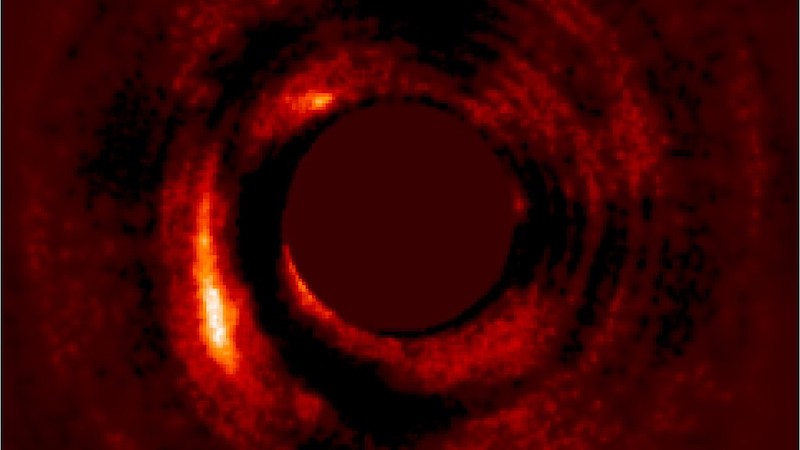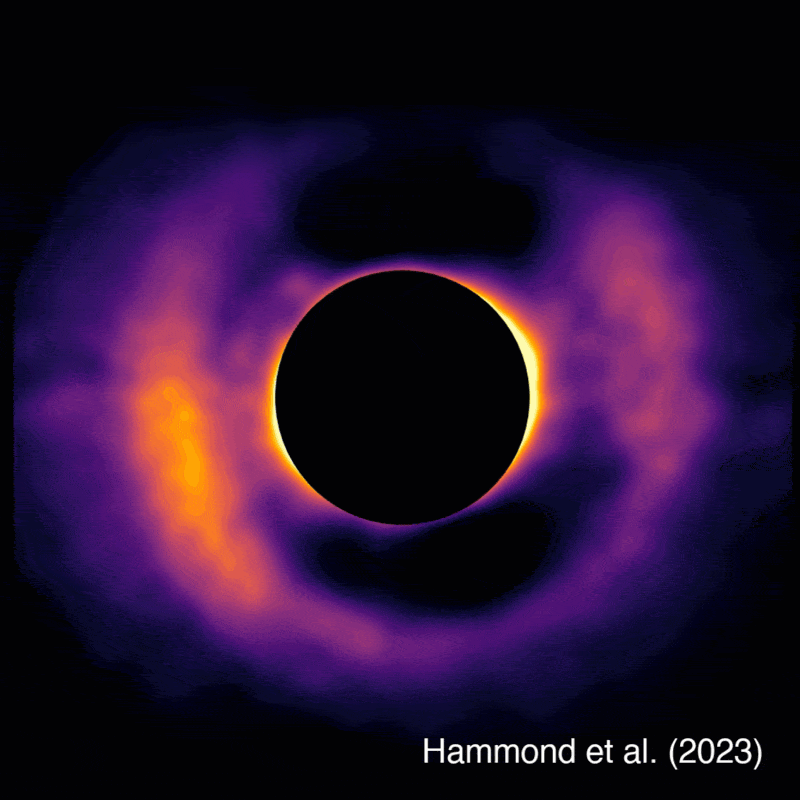
The discovery of thousands of exoplanets – fully formed planets around other stars – is one of the most exciting developments in astronomy. But what about protoplanets? Protoplanets are developing worlds that are still in the process of gathering material and forming. On April 3, 2023, an international team of researchers reported that it has discovered a new protoplanet 374 light-years from Earth. The astronomers made the discovery using the SPHERE instrument on the European Southern Observatory’s (ESO) Very Large Telescope (VLT).
The Monthly Notices of the Royal Astronomical Society (MNRAS) has accepted the researchers’ new paper for publication. You can currently read the preprint version on arXiv.
Meet the newest protoplanet, HD 169142 b
The newly discovered protoplanet, HD 169142 b, resides in a protoplanetary disc, a giant disc of gas and dust that surrounds the young star HD 169142. These discs are the birthplaces of planets. Lead author Iain Hammond, at Monash University in Australia, said:
We used observations from the SPHERE instrument of the European Southern Observatory’s (ESO) Very Large Telescope (VLT) obtained on the star HD 169142, which was observed several times between 2015 and 2019. As we expect planets to be hot when they form, the telescope took infrared images of HD 169142 to look for the thermal signature of its formation. With these data, we were able to confirm the presence of a planet, HD 169142 b, about 37 AU from its star, slightly further than the orbit of Neptune.
Astronomer R. Gratton led another team that took the original images with SPHERE between 2015 and 2019. Those images revealed what looked like a protoplanet about 37 astronomical units (AU) from the star. It wasn’t conclusive yet, however. Now, the new research team has further analyzed the images with state-of-the-art image processing tools. Co-author Valentin Christiaens at the University of Liège’s PSILab said:
The last data set considered in our study, obtained in 2019, is crucial for the confirmation of the planet’s motion. This data set had not been published until now.
Gap in the protoplanetary disc
In protoplanetary discs, you can often see gaps. These gaps are where new planets may be forming. The coalescing protoplanet sweeps up gas and dust in its orbit, creating a gap in the disc. And indeed, just such a gap appears in the newest polarized-light images. In addition, there is a spiral arm of material visible in the images, in the wake of the protoplanet. As Hammond noted, this is further confirmation of the protoplanet:
In the infrared, we can also see a spiral arm in the disc, caused by the planet and visible in its wake, suggesting that other protoplanetary discs containing spirals may also harbor yet-undiscovered planets.
The protoplanet itself is immersed in large amounts of dust. The researchers say that this might be a circumplanetary disc. That is a disc, or ring, of gas and dust that surrounds a protoplanet. It is in these kinds of discs that moons can form.
Other protoplanet discoveries
The PDS 70 star system is 370 light-years away. In 2018 and 2019, astronomers announced the discovery of two giant protoplanets – PDS 70 b and PDS 70 c – orbiting the young star. Later, in 2020, new evidence further confirmed the existence of both protoplanets.
In addition, in 2019, astronomers said they found evidence for a circumplanetary disc around the protoplanet PDS 70 c. That could mean that moons are forming around the planet, or will in the future!
Also, astronomers announced in 2018 that they found evidence for possible protoplanets in a protoplanetary disc around the young star HD 163296. The star is only about four million years old and is located 330 light-years away in the direction of the constellation Sagittarius. Moreover, another team of astronomers said that they detected two possible protoplanets around the same star even earlier, in 2016. They estimated both protoplanets to be about the size of Saturn. They orbited the star at 80 and 140 AU. Then, a third team later said they discovered a third protoplanet orbiting the star, at about 260 AU.

Continued debate
Scientists continue to debate the exact number of confirmed protoplanets, however. As Christiaens explained:
There have been many false positives among the detections of planets in formation over the last ten years. Apart from the protoplanets of the PDS 70 system, the status of the other candidates is still hotly debated in the scientific community. The protoplanet HD 169142 b seems to have different properties to the protoplanets of the PDS 70 system, which is very interesting. It seems that we have captured it at a younger stage of its formation and evolution, as it is still completely buried in or surrounded by a lot of dust.
The new discovery is exciting; HD 169142 b wasn’t the first, but it won’t be the last, either. Given that all planets, including in our own solar system, are born in protoplanetary discs, it’s reasonable to conclude that astronomers will discover more of these discs in the future.
Bottom line: An international team of astronomers has discovered a new protoplanet – a young, still-forming planet – 374 light-years from Earth. It is still buried in dust.
Source: Confirmation and Keplerian motion of the gap-carving protoplanet HD 169142 b
The post New protoplanet discovered 374 light-years away first appeared on EarthSky.
from EarthSky https://ift.tt/FrjKlQg

The discovery of thousands of exoplanets – fully formed planets around other stars – is one of the most exciting developments in astronomy. But what about protoplanets? Protoplanets are developing worlds that are still in the process of gathering material and forming. On April 3, 2023, an international team of researchers reported that it has discovered a new protoplanet 374 light-years from Earth. The astronomers made the discovery using the SPHERE instrument on the European Southern Observatory’s (ESO) Very Large Telescope (VLT).
The Monthly Notices of the Royal Astronomical Society (MNRAS) has accepted the researchers’ new paper for publication. You can currently read the preprint version on arXiv.
Meet the newest protoplanet, HD 169142 b
The newly discovered protoplanet, HD 169142 b, resides in a protoplanetary disc, a giant disc of gas and dust that surrounds the young star HD 169142. These discs are the birthplaces of planets. Lead author Iain Hammond, at Monash University in Australia, said:
We used observations from the SPHERE instrument of the European Southern Observatory’s (ESO) Very Large Telescope (VLT) obtained on the star HD 169142, which was observed several times between 2015 and 2019. As we expect planets to be hot when they form, the telescope took infrared images of HD 169142 to look for the thermal signature of its formation. With these data, we were able to confirm the presence of a planet, HD 169142 b, about 37 AU from its star, slightly further than the orbit of Neptune.
Astronomer R. Gratton led another team that took the original images with SPHERE between 2015 and 2019. Those images revealed what looked like a protoplanet about 37 astronomical units (AU) from the star. It wasn’t conclusive yet, however. Now, the new research team has further analyzed the images with state-of-the-art image processing tools. Co-author Valentin Christiaens at the University of Liège’s PSILab said:
The last data set considered in our study, obtained in 2019, is crucial for the confirmation of the planet’s motion. This data set had not been published until now.
Gap in the protoplanetary disc
In protoplanetary discs, you can often see gaps. These gaps are where new planets may be forming. The coalescing protoplanet sweeps up gas and dust in its orbit, creating a gap in the disc. And indeed, just such a gap appears in the newest polarized-light images. In addition, there is a spiral arm of material visible in the images, in the wake of the protoplanet. As Hammond noted, this is further confirmation of the protoplanet:
In the infrared, we can also see a spiral arm in the disc, caused by the planet and visible in its wake, suggesting that other protoplanetary discs containing spirals may also harbor yet-undiscovered planets.
The protoplanet itself is immersed in large amounts of dust. The researchers say that this might be a circumplanetary disc. That is a disc, or ring, of gas and dust that surrounds a protoplanet. It is in these kinds of discs that moons can form.
Other protoplanet discoveries
The PDS 70 star system is 370 light-years away. In 2018 and 2019, astronomers announced the discovery of two giant protoplanets – PDS 70 b and PDS 70 c – orbiting the young star. Later, in 2020, new evidence further confirmed the existence of both protoplanets.
In addition, in 2019, astronomers said they found evidence for a circumplanetary disc around the protoplanet PDS 70 c. That could mean that moons are forming around the planet, or will in the future!
Also, astronomers announced in 2018 that they found evidence for possible protoplanets in a protoplanetary disc around the young star HD 163296. The star is only about four million years old and is located 330 light-years away in the direction of the constellation Sagittarius. Moreover, another team of astronomers said that they detected two possible protoplanets around the same star even earlier, in 2016. They estimated both protoplanets to be about the size of Saturn. They orbited the star at 80 and 140 AU. Then, a third team later said they discovered a third protoplanet orbiting the star, at about 260 AU.

Continued debate
Scientists continue to debate the exact number of confirmed protoplanets, however. As Christiaens explained:
There have been many false positives among the detections of planets in formation over the last ten years. Apart from the protoplanets of the PDS 70 system, the status of the other candidates is still hotly debated in the scientific community. The protoplanet HD 169142 b seems to have different properties to the protoplanets of the PDS 70 system, which is very interesting. It seems that we have captured it at a younger stage of its formation and evolution, as it is still completely buried in or surrounded by a lot of dust.
The new discovery is exciting; HD 169142 b wasn’t the first, but it won’t be the last, either. Given that all planets, including in our own solar system, are born in protoplanetary discs, it’s reasonable to conclude that astronomers will discover more of these discs in the future.
Bottom line: An international team of astronomers has discovered a new protoplanet – a young, still-forming planet – 374 light-years from Earth. It is still buried in dust.
Source: Confirmation and Keplerian motion of the gap-carving protoplanet HD 169142 b
The post New protoplanet discovered 374 light-years away first appeared on EarthSky.
from EarthSky https://ift.tt/FrjKlQg

Aucun commentaire:
Enregistrer un commentaire